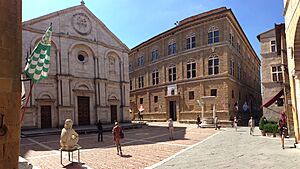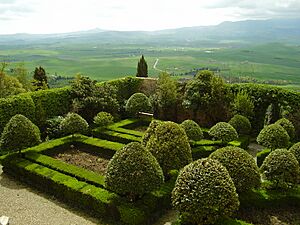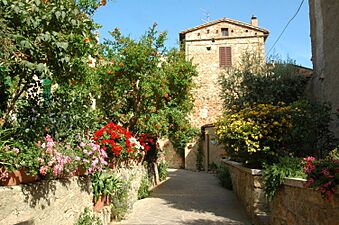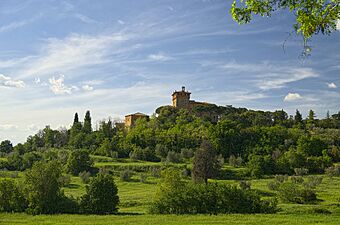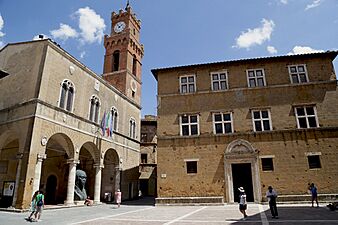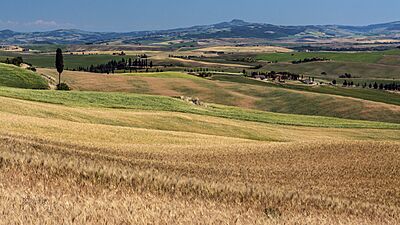Pienza facts for kids
Quick facts for kids
Pienza
|
||
|---|---|---|
| Comune di Pienza | ||
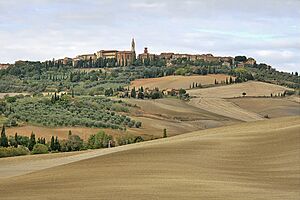 |
||
|
||
| Country | Italy | |
| Region | Tuscany | |
| Province | Siena (SI) | |
| Frazioni | Cosona, La Foce, Monticchiello, Palazzo Massaini, Spadaletto | |
| Area | ||
| • Total | 122.96 km2 (47.48 sq mi) | |
| Elevation | 491 m (1,611 ft) | |
| Population
(28 February 2017)
|
||
| • Total | 2,091 | |
| • Density | 17.006/km2 (44.044/sq mi) | |
| Demonym(s) | Pientini | |
| Time zone | UTC+1 (CET) | |
| • Summer (DST) | UTC+2 (CEST) | |
| Postal code |
53026
|
|
| Dialing code | 0578 | |
| Patron saint | St. Andrew the Apostle | |
| Saint day | November 30 | |
| UNESCO World Heritage Site | ||
| Official name | Historic Centre of the City of Pienza | |
| Criteria | Cultural: (i)(ii)(iv) | |
| Inscription | 1996 (20th Session) | |
| Area | 4.41 ha (10.9 acres) | |
Pienza (pronounced pee-EN-tsa) is a charming town in the Tuscany region of Italy. It's located in a beautiful area called the Val d'Orcia, nestled between the towns of Montepulciano and Montalcino. Pienza is famous for being a perfect example of a "Renaissance city."
In 1996, UNESCO recognized Pienza as a World Heritage Site because of its important history and architecture. Later, in 2004, the entire Val d'Orcia valley was also added to the UNESCO list as a "World Cultural Landscape," meaning it's a special place where nature and human culture have blended beautifully over time.
Contents
History
Before it was called Pienza, this village was known as Corsignano. We first find mentions of it in old documents from the 800s. Around the year 1300, parts of Corsignano became owned by the Piccolomini family. This happened after Enghelberto d'Ugo Piccolomini received land in the Val d'Orcia from Emperor Frederick II in 1220. In the 1200s, Franciscans (a group of monks) also settled in Corsignano.
In 1405, a very important person named Aeneas Silvius Piccolomini was born in Corsignano. He was a smart thinker and writer from the Renaissance period. Later, he became Pope Pius II. Once he was Pope, Piccolomini decided to rebuild his hometown completely. He wanted it to be an ideal Renaissance town, and he renamed it Pienza, which means "city of Pius."
Pope Pius II planned Pienza as a peaceful place to escape from Rome. It was one of the first times that new ideas about urban planning (designing cities) from the Renaissance were used. This project inspired other towns and cities in Italy and eventually spread across Europe.
The rebuilding work was done by a Florentine architect named Bernardo Gambarelli, also known as Bernardo Rossellino. He might have worked with another famous humanist and architect, Leon Battista Alberti, but we don't have clear proof. Alberti was working for the Pope at the time and gave advice to Pius. Construction started around 1459. Pope Pius II officially opened the main church, the Duomo, on August 29, 1462, during a long summer visit. He even wrote a detailed description of the buildings in his own writings, called Commentaries.
In 2023, Pienza had a small controversy. The bells in its old clock tower, which had rung for centuries, were silenced at night. This was because some tourists staying in nearby hotels complained about the noise. This decision caused a debate among the people living there. Some missed the nightly bells, which had been a part of their lives for many generations.
Main Sights
Pienza's main square is shaped like a trapezoid (a shape with four sides, where two are parallel). Four important buildings surround this square.
Palazzo Piccolomini
The most important building is the Palazzo Piccolomini, which stands on the west side of the square. It has three floors, decorated with columns and fancy borders. Each section has a double window. This building looks a lot like other palaces designed by Alberti in Florence.
Inside, the palace has a beautiful courtyard. At the back, facing south, there are loggias (open galleries) on all three floors. These overlook a lovely Italian Renaissance garden with special designs from the Giardino all'italiana style. From here, you can see the distant landscape of the Val d'Orcia and Pope Pius's favorite mountain, Monte Amiata. Below the garden, there's a stable that could hold 100 horses!
The Duomo
The Duomo (Cathedral) is the main church and stands proudly in the center of the square. Its front (facade) is one of the earliest examples of Renaissance design. The way it's divided into three parts is common, but using columns and arches in this way was new for the time.
The bell tower looks a bit German. The inside of the church also has a German style, called a Hallenkirche plan. This means it has three aisles, and the side aisles are almost as tall as the main middle aisle. Pope Pius had spent many years in Germany before becoming Pope, and he liked how light filled these German hall churches. Inside the Duomo, you can see five beautiful paintings on the altars. These were made by artists from the Sienese School, including Sano di Pietro, Matteo di Giovanni, Vecchietta, and Giovanni di Paolo. The Baptistry, where baptisms take place, is next to the back of the church.
Palazzo Vescovile
Pope Pius encouraged important church leaders (cardinals) to build palaces in Pienza to help complete the city. The Palazzo Vescovile (Bishop's Palace) is on the third side of the square. It was built by Cardinal Rodrigo Borgia, who later became Pope Alexander VI. He built it because Pope Pius II asked cardinals to have a home in the town.
When Pienza became a bishopric (a city with a bishop), this palace became the home of the Bishop of Pienza in 1462. Today, it houses the Diocesan Museum and the Museo della Cattedrale. These museums display local fabrics and religious items. You can also see paintings, including a 12th-century painted cross, and works from the 1300s by Pietro Lorenzetti and Bartolo di Fredi. There are also important works from the 14th and 15th centuries, like a Madonna painting believed to be by Luca Signorelli.
Palazzo Comunale
Across from the Duomo is the town hall, or Palazzo Comunale. When Corsignano became an official city, it needed a town hall that fit its new important status. It has a three-arched open gallery on the ground floor facing the Cathedral, and the council meeting room is above it. It also has a brick bell tower, which is shorter than the cathedral's tower. This was to show that the church had more power than the town government. A part added to the tower dates from 1599. It's thought that Bernardo Rossellino designed the Palazzo Comunale to be a link between the religious space in front of the cathedral and the everyday market square behind it.
The stone well in the Piazza has the Piccolomini family crest on it. Many similar wells were copied in Tuscany in the next century. The top of the well looks like a shallow, fluted bowl. The columns supporting it are based on classical designs.
Other Buildings
Other buildings in Pienza from the time of Pope Pius II include the Ammannati Palace, named after Cardinal Jacopo Piccolomini-Ammannati. There's also a row of three palaces called the "curial row" behind the Bishop's Palace. These belonged to important church officials like Cardinal Jean Jouffroy, Vatican Treasurer Giliforte dei Buonconti, and papal relative Gregorio Lolli. Along the main road, you can also find the Palazzo Gonzaga, built in 1463 by Cardinal Francesco Gonzaga, and the Palazzo Forteguerri, built in 1460. The Palazzo of Ambrogio Spannocchi, now called Cittadini, is also from the 15th century. In the northeast part of Pienza, there's a group of twelve row houses built by a contractor from Siena, Pietro Paolo da Porrina, following the Pope's orders.
About fifty meters west of the Cathedral Square is the church of San Francesco. It has a pointed roof and a Gothic-style entrance. This church is one of the buildings that survived from the old Corsignano. It was built on top of an even older church from the 700s. Inside, you can see frescoes (wall paintings) showing the life of Saint Francis. These were painted by 14th-century artists from the Sienese School, Cristofano di Bindoccio and Meo di Pero.
The Romanesque Pieve of Corsignano is a church located nearby. The monastery of Sant'Anna in Camprena was started between 1332 and 1334 by Bernardo Tolomei as a quiet place for Benedictines (another group of monks). It was rebuilt later in the 1400s and early 1500s, and several times after that. The dining hall (refectory) has frescoes by il Sodoma from 1502–1503.
Monticchiello
The small village of Monticchiello is home to a special Romitorio, which is a series of caves carved into the rock by hermit monks. In the same area, there's the pieve (church) of Santi Leonardo e Cristoforo. It was rebuilt in the 1200s in the Gothic style. Inside, it has frescoes from a 14th-century Sienese painter, a small Gothic-style cyborium (a canopy over an altar), and a 15th-century Crucifix. At San Pietro in Campo, you can find the remains of an old abbey.
Monticchiello was also featured in a documentary film called Spettacolo (2017).
Gallery
See also
 In Spanish: Pienza para niños
In Spanish: Pienza para niños



